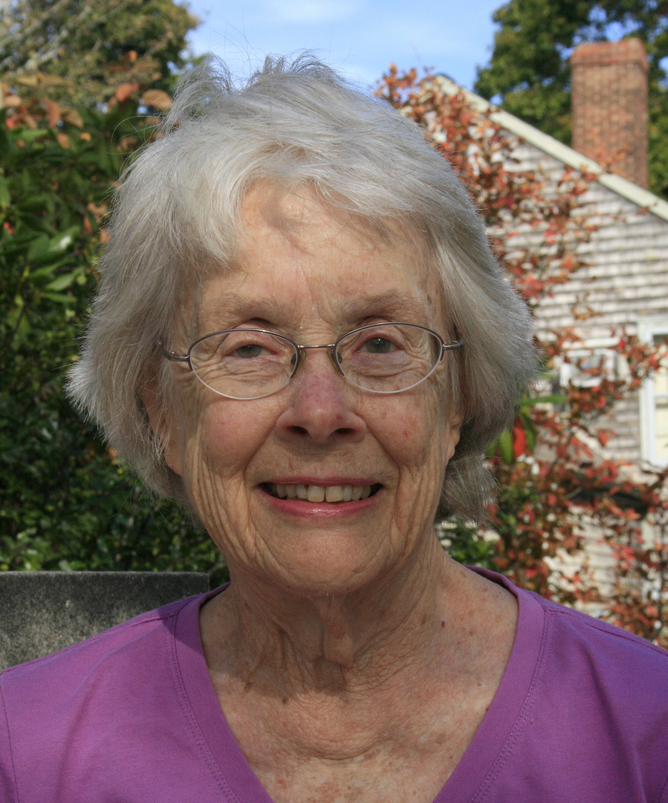
Ellen Garnett Wyttenbach
Born 1929, Farmville, VA, to Mary Brumfield and William R. Garnett
Education: graduated from public schools in Birmingham, AL, 1947
B.A., Duke University, 1951
M.A., Wellesley College, 1953
Ph.D., Indiana University, 1958
Associate Professor, Biology Department, Hendrix College, Conway, AK, 1958-1959; Research Associate in various
labs and years at the University of Chicago and University of Kansas
Married in Alexandria, VA, to Charles R. Wyttenbach, 1959
Children: Robert Alan, b. 1961, Ann Garnett, b. 1962, and Rebecca Jean, b. 1965
Grandchildren: six
Summer spent in Woods Hole: 1958, 1961, and 1964 to the present. (Charles, in addition to those years, had spent most summers, 1953-1957 [and 1958], at the MBL as a Research Assistant to Dr. Sears Crowell of Indiana University.)
Charles and I had met at Indiana University, but it was in Woods Hole that our acquaintance deepened to friendship and more. When I finished the work required for my degree at IU, I asked Dr. Richard Starr, who headed the Botany course at the MBL, if I could join his class there, regarding it as a sort of working vacation in a place I had heard was too wonderful to be true. Charles, though now a student of Dr. James Ebert at Johns Hopkins University, continued working with Dr. Crowell here. In later summers, Charles kept on with the research begun with Sears until the early 1970s, but as his winter research was always very different and not amenable to pursuit at the BML, he has had no MBL lab since then.
After our marriage, we moved to Chicago, where Charles had accepted a position teaching embryology to freshman medical students in the University of Chicago's Anatomy Dept. We moved to Kansas in 1966 when he accepted a position in the Zoology Dept. at the University of Kansas, where his duties and opportunities were a much better match to his interest. He stayed with KU until retirement in 1997. We migrated to Woods Hole in late spring and have never to this day spent a summer in Kansas.
In 1961 we lived in one of the Do Re Mi houses, Re, I think; then, from 1964, one summer in the Brick Apartment building, four on Devil's Lane, and one on Memorial Circle. In 1970 we had to rent on the outside and so learned the cost of non-MBL housing. Either Charles would have to find some other line of summer research or we would have to buy or build here. We found an empty lot on Harbor Hill Road that August and I drew up plans over the winter for a house to fit the lot. In summer 1971 we contracted with Fred DeMello, well-regarded as a builder of many summer homes for MBL researchers, and in June 1972 we moved into its skeleton. We lived within as the interior walls went up around us. (Ironically, we had barely built this house when an MBL lab became unnecessary for Charles's research!) Not until about ten years ago did we finish the interior walls and, by insulating the outer ones, make the house winter-worthy.
All our children learned to swim at Stony Beach and attended Science School as students until they became Assistants. I drove for field trips, much preferring that to desk duty. Then I worked two years on the Sustaining Fund, afterwards serving, 1979-1981, on the Board. Before Charles's retirement in 1997, our summers here ended in mid-August. Afterwards we have stayed until late October enjoying the blue skies, clear horizons, and fewer tourists.
Our major summer pleasure has been attending weekly performances of light opera at Highfield Theater: by the Oberlin College Gilbert and Sullivan Players until 1968 (the G&S operettas are by far our favorite musical comedies) and then by its successor, the College Light Opera Company. From 1964 on, we haven't missed a season, and every opening night finds us in our front row seats. Other recurring pleasures include walking (for many years with our Italian Greyhounds, by whom we were no doubt recognized), visiting with local friends and entertaining out-of-town visitors, seeing the exhibits by the MBL, WHOI, Historical Museum, and Aquarium, and attending lectures sponsored by those institutions and by the Woods Hole Research Center. At home, bird feeders provide entertainment every hour of every day, as more than 100 lbs. of seeds are consumed each summer. In recent years, we have enjoyed watching the excitement as our two under-10-year-old grandsons absorb the unique community science atmosphere, explore the local natural history, and experience the Highfield performances. And when the walls at home begin to close in, our Library provides a comfortable and inviting haven with its good collection suitable for recreational reading.
Except in the summer of 1960 when we undertook a two-month-long, 10,000-mile tour of National Parks in the northwest states and Provincial Parks in western Canada, living in a VW Microbus we converted into a camper, all our summers, 1961 and 1964 onward, have been spent in Woods Hole. Now that Charles has retired and can indulge a passion for photographing wildlife in the wild, we have ventured further afield, chronologically since 2001: Antarctica, the Sub-Antarctic Islands of New Zealand, Baja California, Mexico (for whale-watching), Iceland (including circumnavigating it and sailing northward to circle and land on Jan Mayen Island, Norway), "Wild Scotland" (which extended to the Faeroe Islands), Alaska (small boat cruise and Denali), "India Wildlife Safari", Churchill, Manitoba (polar bears), and, in 2013, the Galapagos Islands and upper Amazon River Basin in Ecuador. During the past 20 years, I have also visited friends and family based in Spain, Switzerland, and England.
It all began for me with a lighthearted wish to experience Woods Hole, and I feel very lucky to have had the adventures that followed.
